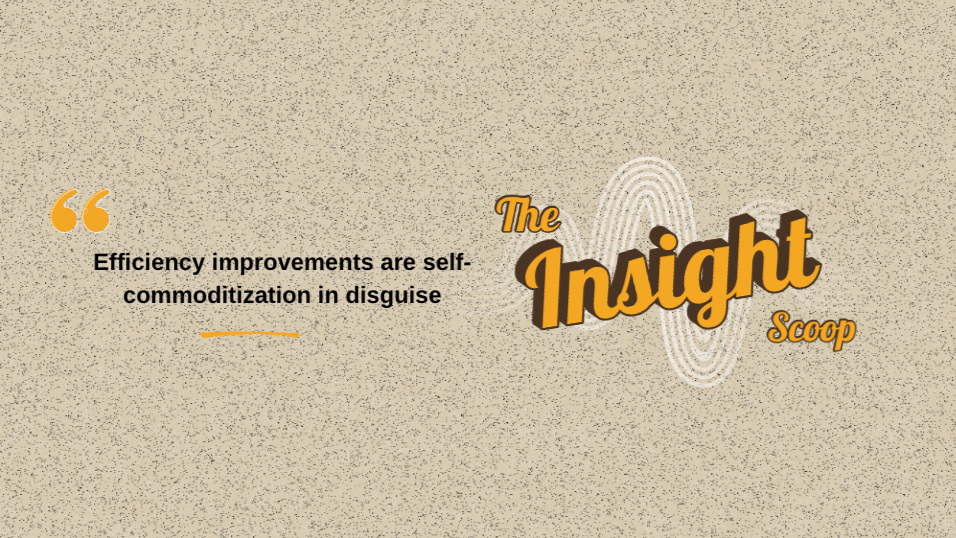From Theory to Practice: How Sangeet Choudary's Systems Thinking Unlocks Real AI Transformation
Blog Post Body
Table of Contents
Talk to a Work Strategist
See the Work Operating System in action and start re-engineering work for AI.
Subscribe to our newsletter
The latest insights on re-engineering work for AI
Sangeet Choudary: bestselling author of Reshuffle and one of the most rigorous strategic thinkers I’ve met, joined me on Episode 18 of The Meg & Amy Show. We cut through the theory and focused on how companies can actually put his frameworks to work.
This conversation was too powerful to leave to chance, so I’ve written it up and I’m putting it straight in your hands.
Read it. Share your take in the comments. Let’s start the conversation.
Moving beyond the hype to build transformation muscle
In our recent conversation with bestselling author Sangeet Paul Choudary, we discovered something remarkable: his framework for understanding structural change doesn't just explain what's happening with AI—it provides a roadmap for organizations ready to move beyond tactical optimization to genuine transformation.
But here's what made our discussion particularly compelling: the intersection between Choudary's theoretical insights and the practical realities we're seeing with organizations struggling to scale their AI initiatives. While his book "Reshuffle" brilliantly diagnoses the problem of playing by old rules in a new game, our work with enterprise clients reveals the specific systems, processes, and coordination mechanisms needed to actually play the new game.
The task optimization trap: Why efficiency is a race to zero value
Choudary's most urgent warning isn't just about pace of change—it's about the strategic death spiral of task optimization. When organizations focus primarily on using AI to make existing tasks more efficient, they're actually commoditizing their own value creation.
This creates what we might call the "efficiency paradox": the more successful you are at optimizing individual tasks, the more you strip away the scarcity and uniqueness that made those tasks valuable in the first place. That AI-powered process automation your team celebrated six months ago? It didn't just become table stakes—it actively contributed to making your entire function more commodity-like.
As Choudary explains through his concept of strategic commoditization, smart competitors deliberately commoditize what was previously valuable, forcing everyone else to compete for scraps while they capture value in entirely new areas. The cruel irony is that organizations pursuing task optimization are essentially doing this to themselves.
This isn't just about acceleration—it's about fundamental value destruction. Companies that focus exclusively on efficiency improvements are systematically eliminating the leverage points that allowed them to capture value in the first place. They're optimizing themselves out of strategic relevance.
Strategic commoditization in practice: Beyond theory to implementation
Choudary's concept of "strategic commoditization"—deliberately making valuable industry elements into commodities to capture value elsewhere—provides the strategic framework. But our client work reveals the operational reality: most organizations struggle to identify where to apply this thinking, let alone how to execute it systematically.
Consider his example of Alliance Jio in India, which invested $40 billion in 4G infrastructure and then offered data and voice services for free, capturing 400 million users by commoditizing what competitors charged for. The insight is brilliant, but how does a mid-market manufacturing company or financial services firm apply this framework to their AI transformation?
This is where the intersection of theory and practice becomes critical. Organizations need systematic approaches that help teams move from optimization thinking to invention thinking, then bridge that invention directly to implementation.
From task optimization to strategic transformation
Most organizations approach AI transformation by starting with task optimization—making existing processes faster or more efficient. Choudary argues this fundamentally misses the point, and our client experience confirms it. The real power isn't in doing tasks faster; it's in enabling complex strategic concepts to work in entirely new ways.
Consider his shipping container example: containerization didn't just make loading and unloading ships more efficient—it fundamentally restructured global trade. The standardized container enabled new coordination patterns between ships, trucks, trains, and ports that weren't possible before. Suddenly, the bottleneck shifted from the loading process to supply chain orchestration, creating entirely new industries around logistics management.
Similarly, AI's transformative power lies not in automating individual tasks, but in enabling new forms of coordination and value creation that weren't economically feasible before.
But here's the practical challenge: organizations that try to jump directly from task optimization to strategic transformation often fail. They lack what we call "transformation muscle"—the collaborative frameworks and coordination mechanisms needed for continuous reinvention.
This is where Amy's AI Transformation Maturity Model becomes critical. Organizations need spectrum-appropriate approaches that meet them where they are while building capability for where they need to go:
Tactical Optimization provides the foundation—teams learn AI fluency, prove early wins, and establish measurement frameworks. This isn't the end goal, but it's necessary groundwork.
Process Enhancement begins to apply strategic thinking—understanding constraints, coordination costs, and how changes ripple through workflows.
Strategic Transformation applies Choudary's frameworks at scale—strategic commoditization, leverage point identification, and business model reinvention.
Organizational Reinvention enables continuous structural agility—the ability to repeatedly identify and capture new forms of value as the landscape shifts.
The coordination revolution: Where the real value lives
One of Choudary's most powerful insights is that AI's greatest value lies not in automation but in coordination. "The way organizations work can fundamentally change if AI can be used to better coordinate across teams and better coordinate the right knowledge into the right workflows," he explains.
This coordination revolution has immediate implications for how we think about organizational transformation. Traditional change management focuses on training people to use new tools. But coordination-centric transformation asks different questions:
- How do we remove coordination constraints that currently limit our agility?
- Where are knowledge bottlenecks preventing the right decisions from reaching the right workflows?
- How do we enable cross-functional teams to invent new coordination patterns rather than just optimize existing ones?
What we envision is a different approach: instead of teams starting transformation initiatives with blank whiteboards, they would be prompted with strategic questions and led through guided discovery processes that help them imagine entirely new possibilities rather than just optimize existing approaches.
Practical implications: Building your guided invention capability
So how do leaders move from understanding Choudary's frameworks to actually implementing them? The key is developing what he calls the ability to "stress test your frames"—actively questioning assumptions about your current business model while exploring how AI might enable entirely new approaches.
This requires four foundational capabilities:
Work Intelligence: Understanding what tasks are currently happening and by whom, the cost of those tasks, and the opportunities for improvement. You can't strategically commoditize what you don't understand. Most organizations think they know how work happens, but detailed analysis reveals surprising bottlenecks and opportunities.
Workflow Intelligence: Identifying constraints, coordination costs, and where leverage points are shifting as new coordination patterns become possible. This isn't just process mapping—it's understanding how AI changes the economics of coordination across your entire ecosystem.
Collaborative Invention: Moving beyond individual optimization to team-based breakthrough discovery. This requires structured approaches that help cross-functional teams envision new workflows that weren't possible before, then bridge those possibilities to implementable plans.
Transformation Execution: Getting people to embrace reinvention rather than resist it. This means reframing "AI will take my job" to "AI will eliminate parts of my current role, but if you participate in reinventing the work, you'll have a better job with higher-value contributions." It's about creating shared ownership of the transformation rather than having change imposed on teams.
The learning-locking organization
Choudary introduces a critical distinction for the AI era: organizations need to be both learning and "locking." Learning organizations adapt and iterate based on feedback. Locking organizations create new structural advantages that are difficult for competitors to replicate.
"A learning organization is very important," he notes, "but you also need what I would call a locking organization." This becomes crucial as transformation timelines compress. The ability to quickly identify new leverage points and lock in structural advantages before they become obvious to everyone else may be the ultimate competitive differentiator.
This insight directly informs how we think about building transformation capabilities. They need to enable both rapid learning from tactical experiments and systematic locking of strategic discoveries into new organizational capabilities.
For leaders, this means moving beyond traditional change management approaches that focus only on adoption and efficiency metrics. Instead, you need transformation approaches that can simultaneously run tactical AI experiments (learning) while identifying and institutionalizing the breakthrough coordination patterns that emerge (locking). Amy's AI Transformation Maturity Model specifically addresses this dual requirement by providing spectrum-appropriate tools that build toward strategic capability while delivering incremental value.
Looking forward: The future of Work Intelligence and planning
Our conversation with Choudary points toward something even more fundamental than individual AI transformations: the emergence of new categories of work intelligence that enable continuous structural agility.
Just as previous technology revolutions eventually produced new management sciences and organizational frameworks, the AI revolution will likely produce new disciplines around system coordination, constraint identification, and collaborative invention. Organizations that begin building these capabilities now—using frameworks like Choudary's combined with systematic implementation approaches—will be positioned to lead their industries through successive waves of structural change.
The future belongs not to those who can predict what's coming, but to those who can systematically recognize new patterns of value creation and act on them before they become obvious to everyone else. The combination of rigorous systems thinking and practical transformation muscle may be exactly what organizations need to thrive in an era of permanent structural uncertainty.
This article was originally published on Insight Loop, the content newsletter from The Meg & Amy Show.
Talk to a Work Strategist
See the Work Operating System in action and start re-engineering work for AI.
Subscribe to our newsletter
The latest insights on re-engineering work for AI


